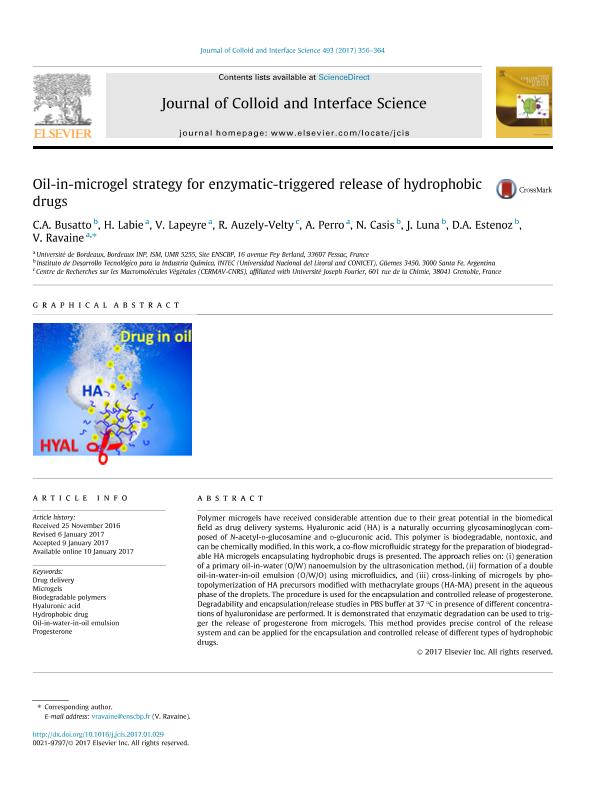Artículo
Oil-in-microgel strategy for enzymatic-triggered release of hydrophobic Drugs
Busatto, Carlos Alberto ; Labie, H.; Lapeyre, V.; Auzely Velty, R.; Perro, A.; Casis, Natalia
; Labie, H.; Lapeyre, V.; Auzely Velty, R.; Perro, A.; Casis, Natalia ; Luna, Julio Alberto
; Luna, Julio Alberto ; Estenoz, Diana Alejandra
; Estenoz, Diana Alejandra ; Ravaine, V.
; Ravaine, V.
 ; Labie, H.; Lapeyre, V.; Auzely Velty, R.; Perro, A.; Casis, Natalia
; Labie, H.; Lapeyre, V.; Auzely Velty, R.; Perro, A.; Casis, Natalia ; Luna, Julio Alberto
; Luna, Julio Alberto ; Estenoz, Diana Alejandra
; Estenoz, Diana Alejandra ; Ravaine, V.
; Ravaine, V.
Fecha de publicación:
11/2016
Editorial:
Elsevier Science
Revista:
Journal of Colloid and Interface Science
ISSN:
0021-9797
Idioma:
Inglés
Tipo de recurso:
Artículo publicado
Clasificación temática:
Resumen
Polymer microgels have received considerable attention due to their great potential in the biomedical field as drug delivery systems. Hyaluronic acid (HA) is a naturally occurring glycosaminoglycan composed of N-acetyl-D-glucosamine and D-glucuronic acid. This polymer is biodegradable, nontoxic, and can be chemically modified. In this work, a co-flow microfluidic strategy for the preparation of biodegradable HA microgels encapsulating hydrophobic drugs is presented. The approach relies on: (i) generation of a primary oil-in-water (O/W) nanoemulsion by the ultrasonication method, (ii) formation of a double oil-in-water-in-oil emulsion (O/W/O) using microfluidics, and (iii) cross-linking of microgels by photopolymerization of HA precursors modified with methacrylate groups (HA-MA) present in the aqueous phase of the droplets. The procedure is used for the encapsulation and controlled release of progesterone. Degradability and encapsulation/release studies in PBS buffer at 37 ºC in presence of different concentrations of hyaluronidase are performed. It is demonstrated that enzymatic degradation can be used to trigger the release of progesterone from microgels. This method provides precise control of the release system and can be applied for the encapsulation and controlled release of different types of hydrophobic drugs.
Palabras clave:
Microgels
,
Drug Delivery
,
Biodegradable Polymers
Archivos asociados
Licencia
Identificadores
Colecciones
Articulos(INTEC)
Articulos de INST.DE DES.TECNOL.PARA LA IND.QUIMICA (I)
Articulos de INST.DE DES.TECNOL.PARA LA IND.QUIMICA (I)
Citación
Busatto, Carlos Alberto; Labie, H.; Lapeyre, V.; Auzely Velty, R.; Perro, A.; et al.; Oil-in-microgel strategy for enzymatic-triggered release of hydrophobic Drugs; Elsevier Science; Journal of Colloid and Interface Science; 493; 11-2016; 356-364
Compartir
Altmétricas



